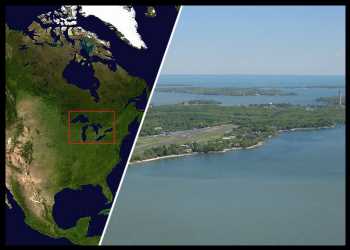Biden Announces $1 Bln For Restoration Of Polluted Great Lakes

President Joe Biden has announced an investment of $1 billion from the Bipartisan Infrastructure Bill to accelerate cleanup and restoration of the Great Lakes’ most environmentally degraded sites.
Speaking at The Shipyards in Lorain, Ohio, Biden said his administration is going to accelerate cleanup of sites across six states in the Great Lakes Basin — from Duluth, Minnesota, to Milwaukee, Wisconsin; Gary, Indiana, to Buffalo, New York, which have been dangerously polluted for decades.
The projected works include restoring the shoreline around the Detroit River in Michigan, the St. Louis River in Minnesota and Wisconsin, and the Grand Calumet River in Indiana.
The earmarked fund will be used to dredge polluted sediment; restore wetlands and habitats; making the water safer for swimming and fishing and drinking; and providing habitats for wildlife and wildfowl.
Biden said a study found that every dollar spent cleaning up the Great Lakes generates between three and four dollars in economic benefit.
He added that the historic investment his administration is making to restore the Great Lakes will strengthen the region’s economy, provide clean drinking water, clean up communities, and create good-paying jobs.
Last month, the government announced more than $500 million to upgrade the Soo Locks in Michigan, which connect Lake Superior and the Great Lakes.
Seven thousand vessels and 90 percent of the country’s iron ore move through these locks every year.
“Replacing and modernizing the locks will not only create good jobs doing that, it’s going to strengthen our supply chains and get goods moving faster and reduce cost,” Biden said.
The Great Lakes, spread across the United States and Canada, connect eight U.S. states. They provide more drinking water than any set of lakes in the world, benefitting more than 40 million people. They support more than 1,300,000 jobs in manufacturing, tourism, transportation, warehousing, farming, and fishing. And they are essential route to shipping goods made in the Midwest region.
Home to countless natural and cultural resources, generations of families have depended on the Lakes for boating, fishing and hunting.
In 1987, an independent commission identified 43 places called “areas of concern” along the Great Lakes. They are areas where pollution from industry, runoff from agriculture, and poor wastewater treatment put the Great Lakes and everyone who depends on them at risk.
Twenty-six of these areas are in the U.S. side of the border.
Environmental Protection Agency Administrator Michael Regan said that the billion-dollar investment will help clean up 23 of these areas by 2030.
Source: Read Full Article
